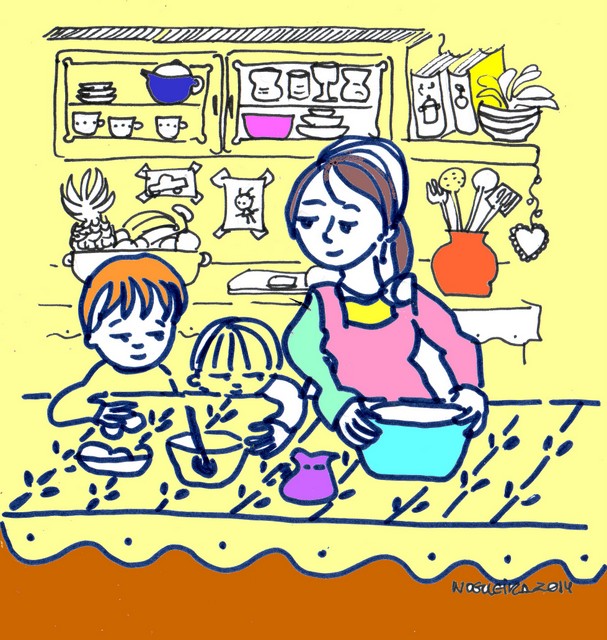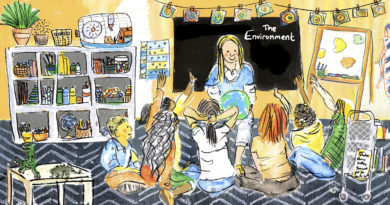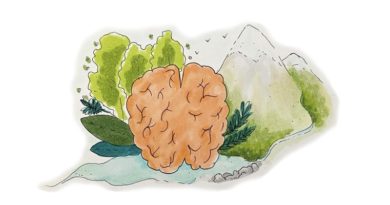A Mother’s Taste for Life
 Teaching Our Children Right from Wrong When It Comes to Healthy Food
Teaching Our Children Right from Wrong When It Comes to Healthy Food
By allowing a child to truly understand the difference between healthy and unhealthy foods by him or herself, instead of taking it as a command because “Mom and Dad said I can’t have it,” and realizing that healthy food can be even more delicious than junk food, the child really forms a sense of self, and an unparalleled independence and basis of educated thinking for the future.
With that in mind, I’d like to share ten top tips, from one mother to another, on how to help our kids distinguish between healthy and unhealthy foods:
Start teaching early. …actually, even before the child is born! Studies have shown that what a pregnant woman eats can affect the development and health of her baby. No, that doesn’t mean “dieting” and “eating for two.” It simply means eating healthily. What you hope and wish that your child will eat when he or she is old enough to eat solid food is exactly what you should be eating before, during, and after the pregnancy.
Remember: this is a lifestyle choice, not a temporary fling. We want to provide an example to our kids, and it starts even before they are born.
Wear your child. It might sound outrageous to you, but “wearing” your child on you when you cook from day one (or at least from the first day you can find the energy to stand in the kitchen again!), will bring the child closer to the kitchen. Smelling the cooked food, seeing how you work and what you do, and eventually seeing you eat it as well (yes, they see everything, and understand a lot more than we think they do) will build a beautiful relationship between the kids and healthy, home-cooked meals.
Mash together. As your child grows and develops (but is still a tiny four- to six-month-old creature), you will already see his or her full interest in the food you eat, and you can start feeling comfortable making them some of the veggies that you used in your own meal, without the spices, and in moderation of course, mashed up. Have them by your side when you prepare the food. When they see the whole process and then see it come all the way into their little mouths, it will be a very exciting moment for the both of you!
Don’t sweat the small stuff. As the kids grow older, it gets harder to keep them healthy, with McDonalds and Starbucks on every corner and kids eating bratwurst and gummy bears everywhere. Going out into the world with the knowledge of what is healthy versus what is not could make life easier for both you and your child. It’s important to explain that a “once in a while” treat, as long as the daily diet is a healthy one, is okay. Empowering your child with the knowledge of moderation will make the bad food less desirable, and it lowers the risk of bingeing and overdoing it in the event that the child does choose to eat junk food once in a blue moon.
Develop an eating-out policy. Parents should reach one important decision together: Is the diet outside of the house going to be the same as the one at home? Reaching a decision to be more flexible outside could make life easier, as long as eating out is not something that happens often. You will then actually find yourselves choosing the healthier choices outside as well, because you know that these are the choices that make you feel better after eating. You are likely to realize that when you want to “treat” yourselves to something naughty, you are going to end up going home with a stomachache.
Remember the how, what, and why. Remember to help your children understand WHY something is unhealthy, WHAT ingredients we want to avoid, and HOW we can make what we crave at home by using healthy, simple, ingredients rather than pre-brought, processed goods.
Naturally detoxify. I’d like to share my surprise when, recently, my less-health-conscious child took one bite of a gummy snake (which I know how much he loves) and then tossed it into the garbage. He had become used to eating our healthy replacements, such as fruit leather (a great alternative to those horrible gummy candies), and suddenly the gummy tasted nasty to him. And to think – he’s the rebel of the two!
Grow your grub. Growing what you eat is a big thumbs up in health education. When kids see how things grow, how long it takes, and all the shapes and forms a fruit or vegetable has before it ends up on our plates, it makes them crave it even more. The first time my kids finally ate lettuce was when they picked their first harvest. It ended up being their whole meal that evening, and they even asked for more! There are many things you can grow on your windowsill or balcony: from tomatoes, to potatoes, and even zucchini, fennel and lettuce. It’s fun, the vegetables taste wonderful and have the most vitamins you can get from a fruit or vegetable, and it will make your kids love eating the produce.
Leave the junk at the shop. If you don’t want your kids to eat unhealthy things, don’t have them at home. There are many things you can have as snacks which you are able to easily make at home or even buy.
Snacks can be natural. Stack up on loads of fruit and vegetables, and always offer them when your kid is hungry and asking for a snack. Soon enough, they will get used to you sending them to the fruit bowl, and will even stop asking. Fruit should be available to the child whenever he or she likes, without even having to ask.
Never give up on offering a fruit or a vegetable you know the kids don’t like. Our palettes change throughout the years, and will keep changing until the day we die. Keep offering the vegetable or fruit every few weeks or so, and show your kids how proud you are of them for trying and tasting, rather than showing disappointment for their disliking it.
By Danna Levy-Hoffmann
Danna, a photographer, devoted cook, and self-proclaimed health freak with an education in both graphic design and child psychology, has just one goal in mind: making tomorrow a better, healthier, more educated version of today. She has discovered many tricks to the trade and would like to offer up some ideas to her fellow mothers who are hungry for a method of teaching their children right from wrong, healthy from unhealthy. To learn more about leading a healthy home, and to find out how much your child’s imagination and coordination can shine through the art of culinary science, contact Chef Danna through her Miso Cute website
Illustration by Albina Nogueira
Albina Nogueira has been a primary school teacher since 1992, and a writer and illustrator since 2006. She currently lives in Switzerland, but her homeland is Portugal. She is also the author of Letters to Grandparents and Hairdresser. To find out more, like her on Facebook or see her books in Amazon.



